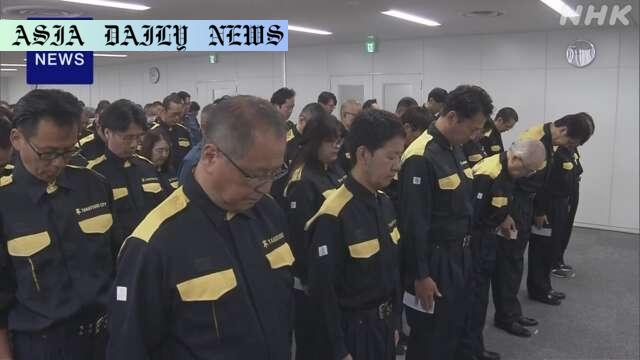Earthquake – Wednesday marks seven years since a powerful earthquake hit northern Osaka Prefecture, killing six and injuring many.
Seven years since the 2018 Osaka earthquake.
The quake claimed six lives, leaving many injured.
Officials and citizens honor the victims through memorials.
Emphasis on preparing for future seismic events.

The Impact of the 2018 Osaka Earthquake
Wednesday marks the seventh anniversary of a tragic event that shook northern Osaka Prefecture in western Japan. In 2018, a powerful earthquake with a maximum intensity of lower 6 on the Japanese seismic scale struck urban areas, most notably Osaka City’s Kita Ward and Takatsuki City. This unexpected disaster claimed six lives, left many residents injured, and caused significant property damage. Among the victims was a young fourth-grade girl in Takatsuki City, whose life was cut short by the collapse of a concrete block wall near an elementary school pool. The quake served as a gut-wrenching reminder of the vulnerability of even urban areas in the face of unpredictable natural calamities.
In Takatsuki City, a memorial ceremony was hosted to honor the lives lost. Mayor Hamada Takeshi, alongside citizens and officials, paid tribute by laying flowers at an altar placed near the school’s main gate. A moment of silence was observed at 7:58 a.m., marking the exact time the quake struck. The gathering was both somber and reflective, urging the community and officials to learn from the past and take concrete steps toward preparation and resilience.
Heightened Risk and the Need for Resilience
The tragedy of the Osaka Earthquake continues to resonate as Japan faces an elevated risk of future earthquakes. The Nankai Trough, located off the Pacific coast of central to southwestern Japan, poses a significant threat. A government committee has recently increased the probability of a massive earthquake, with a magnitude of 8 to 9, occurring along this seismic zone to approximately 80% within the next 30 years. Such findings underline the urgency for preparedness and proactive measures to protect communities.
Mayor Hamada Takeshi, during the memorial, emphasized the importance of building a resilient city. Resilience goes beyond infrastructure; it involves strategic planning, public awareness, and fostering a community spirit geared toward disaster readiness. It is a collective call to action for officials, engineers, architects, and citizens to rethink urban planning and invest in robust safety measures to mitigate damage and save lives during future disasters.
Takatsuki’s Commitment to a Safer Future
Takatsuki City has taken several steps to improve safety following the 2018 earthquake. One crucial lesson learned was the need for sturdier and more resilient infrastructure, as demonstrated by the collapse of the concrete wall that led to a young girl’s death. Authorities have since embarked on wide-scale inspections and updates to public infrastructure, eliminating structural weaknesses that could lead to similar tragedies.
Moreover, community initiatives aimed at raising awareness about earthquake preparedness have gained momentum. Emergency drills, evacuation plans, and education about seismic safety have become regular features in schools, workplaces, and neighborhoods. By fostering a risk-ready mindset, Takatsuki aims to minimize the potential damage of future earthquakes, ensuring a safer environment for all its citizens.
A Broader Call to Action
The 2018 Osaka Earthquake also serves as a reminder for all regions at risk of seismic activity to take immediate action. Japan, located along the Pacific Ring of Fire, is no stranger to earthquakes. However, each event highlights gaps in preparedness, whether in infrastructure, emergency response, or community awareness. It is an ongoing challenge that demands constant vigilance and adaptation to the evolving nature of seismic threats.
Integrating advanced technology, such as early warning systems and earthquake-resistant building designs, plays a significant role in this fight. At the same time, fostering a culture of readiness through public engagement ensures that every individual understands their role in disaster prevention and recovery. These measures, collectively, will not only enhance Japan’s resilience but also set an example for other countries vulnerable to earthquakes.



Commentary
Reflecting on the Lessons of the 2018 Osaka Earthquake
The seventh anniversary of the 2018 Osaka Earthquake offers a poignant moment for reflection. While it is a time to honor the six lives tragically lost, it is also an opportunity to evaluate the progress made in disaster preparedness and address remaining vulnerabilities. The loss of a young girl at Takatsuki City underscores the importance of robust and safety-compliant infrastructure—something that no community can afford to overlook.
The Urgency of Earthquake Preparedness
Japan’s susceptibility to earthquakes is a well-documented reality, making preparedness non-negotiable. With an 80% likelihood of a massive earthquake occurring along the Nankai Trough within the next three decades, the country faces an undeniable challenge. Community resilience must take center stage, backed by technological advancements and strict adherence to safety standards. Natural disasters may be inevitable, but their impact can be mitigated through proactive measures and a unified effort.
Moving Forward as a Resilient Nation
The memorial services held in Takatsuki are a testament to the strength of communal spirit and the commitment to overcoming adversity. Recalling the past while actively preparing for the future is a balance that Japan—and especially cities like Takatsuki—must master. Governments, local authorities, and citizens alike must collaborate to build a safer, more resilient nation.
Ultimately, remembrance and resilience go hand in hand. By honoring the memory of those lost and taking decisive action to protect current and future generations, communities can transform tragedy into a compelling drive for progress and safety. This is not just a task for Japan but a global call to prioritize disaster preparedness amid rising threats posed by our planet’s dynamic forces.